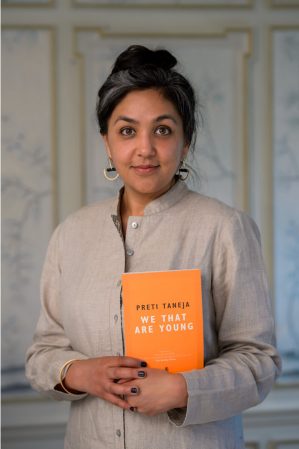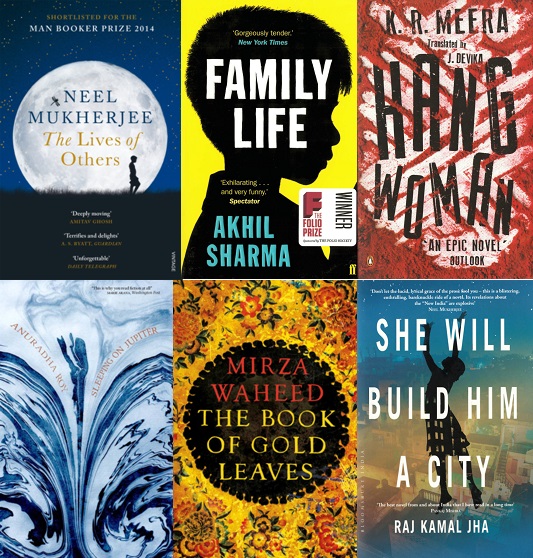CG Menon’s debut collection Subjunctive Moods, is published by Dahlia Press and the predominant mood of it could be what the last story “Rock pools,” poetically describes as ‘our throbbing darkness and our gleeful knowledge of what we lack.’
The characters in this collection have been analysed with almost mathematical precision, to pinpoint and expose their darkest vulnerable spots whilst allowing them mutability. In the background lurk the ghosts of unfulfilled desires, suppressed emotions and the desperation of unrealised hopes. Indeed, the word ‘ghost’ appears an unlucky thirteen times as does pontianaks- Malayan for female vampire. Menon uses ghosts both metaphorically and literally. In “Aunty,” ‘Bibi had cremated two husbands and stoppered them up in vases on her polished windowsills. She knew how to keep ghosts in line,’ while in “Rock pools,” Melissa’s husband comes out of the night ‘bringing the ghosts of salt and seagrass into her caramel home.’ In “The Ampang Line,” the ghosts are past betrayals; ‘all the ghosts crowded into the back seat …Miss Working-Late, Miss Tennis-Partner, Miss She’s-Just-A-Friend-My-God-Shalini-Give-It-A-Rest…’ while in “Watermelon Seeds,” ‘… faces float frail as ghosts somewhere below the water.’ And in case we forget, “Clay for Bones,” reminds us, ‘… in Wales the ghosts are different.’
Menon draws us into the worlds of her characters with lyrical language and rich descriptions of nature. For instance, in many of the stories images of water are used to heighten the sense of foreboding. In “You are Julia,” Julia watches ‘…the sun on water clogged with weeds and rusting tin cans,’ while Catherine observes the ‘queasy suck of waves.’ In “Clay for Bones,” Sweta’s ashes, ‘were scattered in the Periyar river on a rainy Kerala day, with sea fog fleecing the water and the karimeen fish swishing their tails like butter churns.’ In “Seascapes,” initially we find: ‘… a cleft where the water springs fresh and bubbling, finds a cavern just behind it that teems with nymphs and sirens with fish’s tails,” but later we are told, it had ‘… an old taste, a salt-and-decay taste of storms and weed and ocean slime, and murky waters covering things best left forgotten.’ A similar eeriness is conveyed in “Rock pools,” where: ‘The smell of brackish seawater creeps into the kitchen, dank and wet.’
Many of the characters are damaged; they have been intimidated and betrayed. This is hinted at through descriptions of wrecked appliances, fractured body parts, spoilt clothing and missing items. In “I see you in triplicate,” we see ‘his wedding suit – too tight now and punctured by moths,’ ‘the necklace is tangled in a blue silk scarf,’ and ‘a broken-down washing machine.’ In “Peacocks,” we read of a leaking water heater and a lost earring. In “Foxgloves,” there are ‘broken prams,’ and in “Seascapes,” Deepa knows: ‘there’s another part to the story, broken off like a jagged tooth in the back of her mouth.’
In every story at the very moment when we feel there is the possibility of hope in the shape of some relief, we are instead presented with small and brutal acts of violence. In “Daylight Savings” it is the ‘little pinches and slaps,’ and ‘anaemic fight, a bloodless battle dangling limply,’ and in “So Long, So Long,” we are told he would lie next to her, ‘… saying nothing but pinching her thin flesh until it blotched and reddened. He gave her small sorrows, at those times, to drown the bigger ones.’ And aside from the pain inflicted by others, the characters also torture themselves with self- denial. In “Daylight Savings,” Sarah:
‘picks at a cake and puts it back… Sarah’s done well, thinks Amber. She’s dieting and denying herself; she’s getting there.’
But in fact no character in this collection ever gets there, as is seen in, “Subjunctive Moods,” where Sara (with the ‘h’ deliberately taken off Sarah?) is bullied more extremely into depriving herself so that she can become, ‘adorable.’
The setting for CG Menon’s stories is the north of England (Northumberland and Teeside) or Pahang, where she has close family ties. But even though the landscape is beautiful and serene, there is always disease, rot, and decay waiting. The air is quietly menacing; as in “Watermelon Seeds,” where the hall, ‘…smells of silence, of lilies and rosewater and cool polished wood,’ and no matter how far the characters travel or what they do as Sweta points out in “Clay for Bones,” ‘…’Nothing much changes,… and after being dead for fifty years she should know.’ This realisation makes the motif of birds which appears in many of the stories all the more poignant.
Birds are both comforting, and menacing. They are strong and free and at the same time fragile and unreliable. We read how an elderly woman, ‘sighed, and sagged back into her chair as lopsided as a nesting bird,’ in “Dust and Spices” and about ‘scraggy hook-clawed birds tied under their arms,’ in “Clay for Bones.” In the “Names of Things,” trapped birds ‘hissed and fluttered inside,’ their cage when a walking stick was struck against it and later in the same story Robert tries to connect with a bird in vain.
‘He stroked at the bird’s wing almost gently; then with a stiff tug some feathers slipped free. The hen scuffled, hunkered down against the cage floor…’
In “Rock Pools,” the symbolism within the story changes. First the birds are sentinels,
‘The birds lance upwards on spears of damp wind as I approach. All night they’ve been watching us, keeping the sea’s bridal foam from our dreams.’
Jon is ‘Studying the birds, tagging them, assigning meaning to every flight,’ even though the narrator, Lisa, who has ‘seen these seagulls every morning, could tell him all that he wants to know’ and believes them to be enigmatic.
Jon says: “The birds are being driven by hunger. That’s why they’re staying here so long.” And hunger is also a metaphor for love, affection, and the yearning for connection and belonging.
‘That night, the sky darkens with another storm. The air tastes of metal and brackish water and birds pace restlessly on the shore.’
In the closing of the story, Lisa believes she will find solace from the birds, ‘The gulls are waiting for me, clustered by the water’s edge with wavelets lapping at the narrow bands around their legs.’ But she is disappointed because instead, ‘The gulls squawk, fly up in panic and swoop away.’
In “Clay for Bones,” which won the Short Story Prize 2015, birds are the victims of brutal violence and CG Menon is unrelenting in her description:
‘A hand reaches in, fumbling at the soft yellow fluff, and drags one out by its neck. The chick rakes a thin seam of blood across those fingers, then it’s banged smartly against the cage door and pulled up out of view.’
In another moving passage:
‘Under all that rubbish is a dead bird, a little farmyard chick a week or two old. Its yellow fluff is blackened and gummy and its face has been smashed to shards of bone.’
CG Menon’s stories highlight the fragility of relationships. She shows that her broken-winged characters will continually struggle, but she hints at the possibility of them finding consolation from nature. In “Foxgloves,” this is emotively described as: ‘a trail of foxgloves right out of the valleys and into her own happy ending,’ and in “Clay for Bones,” even a dead bird seems for a moment as if it could be revived by a gentle wind as:
‘…A breeze slips across the playground and its stubby wings lift in a wary shiver, as though it might still fly.’
It is this delicate thread of hope running through the collection which gives it its enduring quality.
Farah Ahamed is a short fiction writer. Her stories have been published in The Massachusetts Review, Thresholds, Kwani?, The Missing Slate and Out of Print among others. She was highly commended in the 2016 London Short Story Prize, joint winner of the inaugural Gerald Kraak Award and has been nominated for The Caine and The Pushcart prizes. She was shortlisted for the SI Leeds Literary Prize, DNA/Out of Print Award, Sunderland Waterstones Award, Asian Writer Short Story Prize, and Strands International Short Story.


